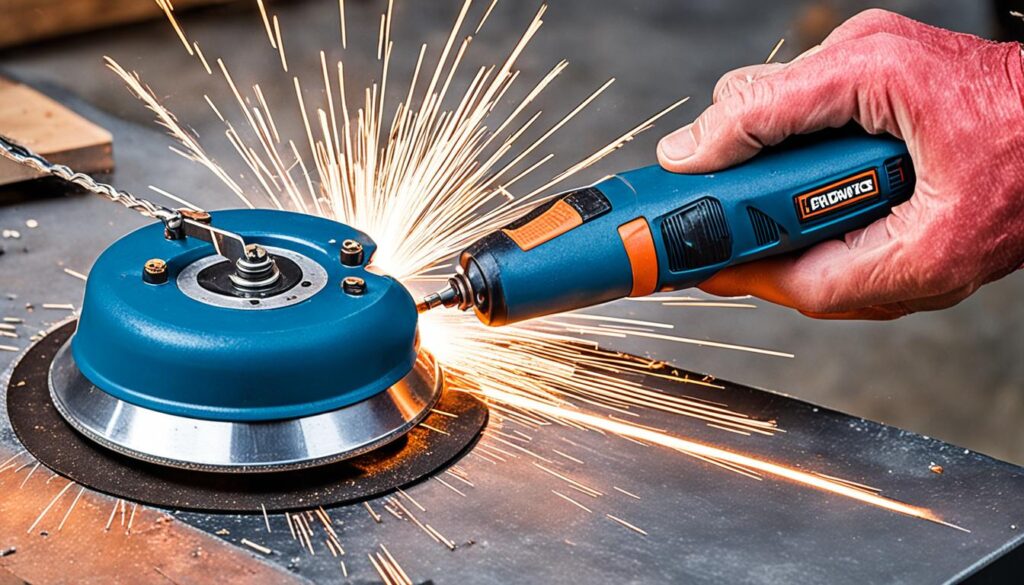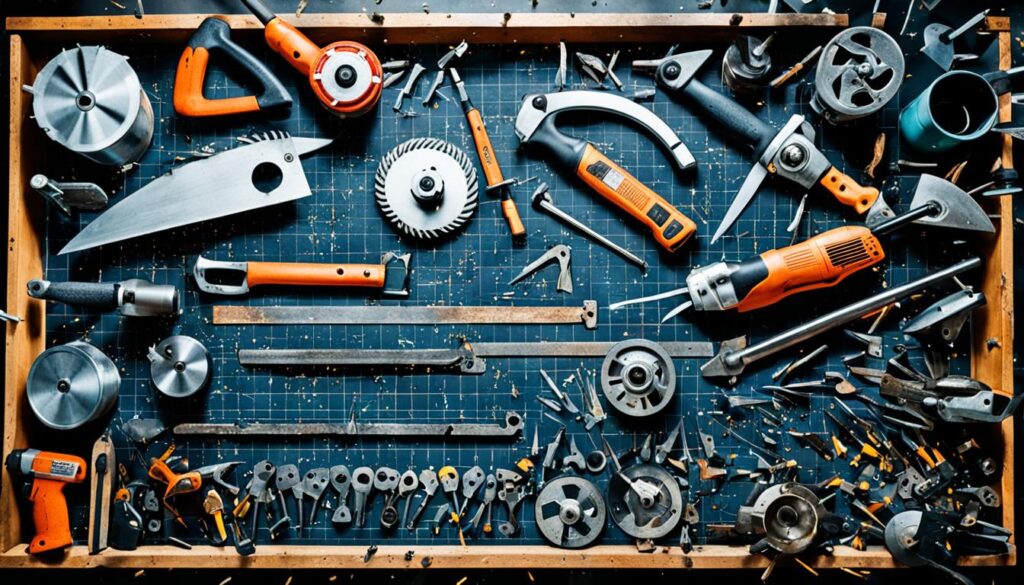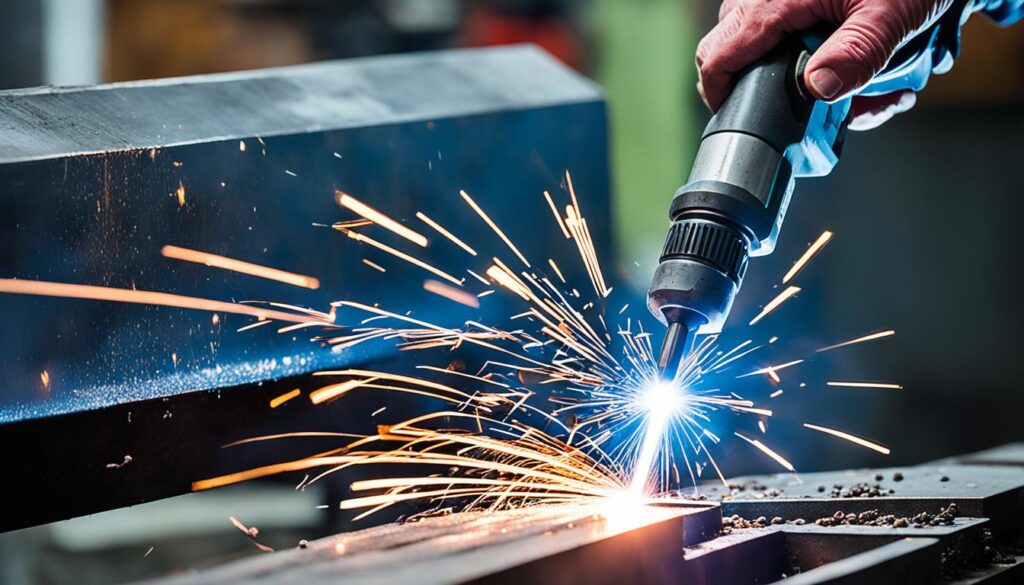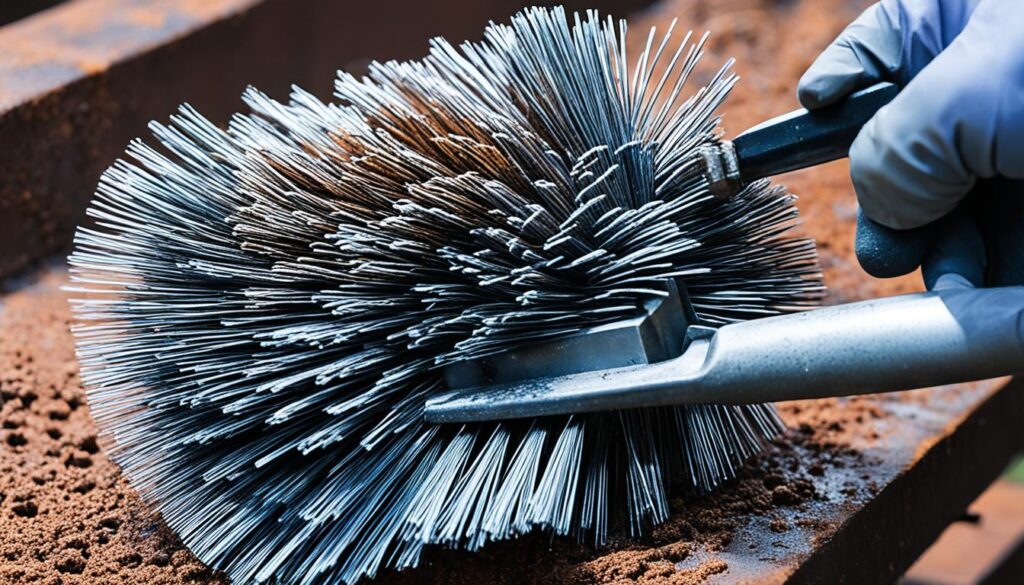
Creating something with your own hands is truly rewarding, especially in metalworking. Remember the first time you used a tool and felt confident? That sense of pride after finishing a project is unmatched. DIY wrought iron projects can boost your skills and refresh your home décor. Whether for custom car builds or fixing household items like lawn mowers, these tips will help you succeed.
At first, wrought iron might seem tough, but the right tools and methods make it easier. Learning the basics, like cutting mild steel with circular saws and using carbide-tooth blades for strength, helps a lot1. Adding miter saws for precise cuts in aluminum rods and tubes also improves your work1. Mastering these tools enhances your skills and invites you to tackle more complex DIY projects.
Starting in metalworking is about more than just using tools. It’s about feeling empowered and creative. As you prepare for your next project, always put safety first. Wear safety glasses, face shields, gloves, and long sleeves to protect yourself1. This way, your projects will be safe and successful.
Key Takeaways
- Embrace the satisfaction that comes from personally completing DIY wrought iron projects.
- Circular saws and carbide-tooth blades are crucial for cutting efficiency and longevity1.
- Miter saws provide precision cuts for aluminum rods, tubes, and angles1.
- Prioritize safety by wearing appropriate protective gear when cutting metal1.
- Enhance your metalworking skills to handle more sophisticated projects, from home repairs to custom builds.
Introduction to Wrought Iron Cutting
Learning the basics of wrought iron cutting is key for DIY fans wanting to tackle metal projects with skill. This process uses various techniques that make it both efficient and safe. Wrought iron is tough and has beautiful designs, but it can be hard to work with. So, using the right methods is a must.
Start by learning the five main ways to cut wrought iron: oxyfuel gas cutting, metal powder cutting, chemical flux cutting, oxygen lance cutting, and oxygen arc cutting2. Each method uses different gases like acetylene, natural gas, propane, MAPP gas, and hydrogen, offering unique benefits such as high flame temperatures and gas ratios2. Knowing these options helps you pick the best one for your project.
For cutting wrought iron at home, using silicon carbide cut off wheels is often best because they’re tough and can handle high heat3. Make sure to use a 4.5-inch cut off wheel for cutting cast iron pipes3. Always wear safety gear like safety glasses, gloves, and a dust mask or respirator to protect yourself from flying debris or dust3.
Wrought iron cutting can be done with different tools and methods. For precise cuts, a reciprocating saw with a carbide-tipped blade works better than an angle grinder, as it creates less dust and is easier to control. But, the angle grinder might heat up the material, so you’ll need more protective gear4. Understanding these basics and how to use your tools safely will improve your DIY metal cutting skills.
Tools for Cutting Wrought Iron
Working on DIY projects with wrought iron requires the right tools. You might use traditional hacksaws or advanced power tools. It’s key to pick the best cutting tools and safety gear.
Choosing the Right Blade
It’s vital to pick the right metal cutting blades for smooth cuts. A diamond blade cuts through ferrous metals well, unlike abrasive grinder discs. For precise cuts on smaller projects, use a hacksaw with a titanium-coated high-speed steel saw blade5.
For consistent results, mark the cutting area with high-contrast colored paint or a marker5. An angle grinder with a cut-off wheel is great for big projects needing quick, precise cuts6. Choosing thin cutting wheels for the angle grinder makes for a neat cut6.
Must-Have Power Tools
Using the right power tools can make cutting wrought iron more efficient and fun. Popular tools include oxyacetylene torches and right angle grinders5. DIY fans often prefer an angle grinder, like a 4 1/2 inch model, for its ease and versatility7.
It’s great for grinding and cutting steel too7. A Dewalt 4.5″ hand grinder with a .045 cutting disc is good for cutting iron railings quickly7. A reciprocating saw with a metal blade is also handy for straight, clean cuts6.
Safety Equipment
Staying safe while cutting wrought iron is crucial. Wear safety glasses, welding helmets, and full leathers to protect against flames and metal debris56. Keep a fully-charged ABC fire extinguisher nearby when using torches or grinders5.
Type C sheetrock is fire-resistant and can protect your workspace5. Use proper cutting techniques, like steady pressure and strokes away from your body, to avoid injuries5.

How to Cut Wrought Iron
Cutting wrought iron well needs the right tools, methods, and safety steps. Start by picking the right tools like a hacksaw or an angle grinder with a cutoff wheel8. For cutting metal, use a blade with at least 6 teeth per inch, but 14-18 teeth per inch is best8. Adjust the blade speed to avoid discoloration, especially for thicker pieces8. Always wear protective gear and keep the area clear to avoid accidents.
Using different tools changes how you cut wrought iron. For example, a Dewalt 4.5″ hand grinder with a .045 cutting disc can cut iron railing in about 15 minutes7. A reciprocating saw or jigsaw works well for thicker pieces9. When cutting, measure carefully; for iron balusters, add 3/4″ to the measurement from floor to handrail for a good fit9.
Applying cutting oil helps make cutting easier and extends blade life. Some say soapy water works well for occasional cuts8. After cutting, smooth out the edges to prevent injuries7. Be careful when using an angle grinder indoors because sparks can start fires8. For detailed work, use a Portaband Saw or chop saw with a metal blade9.
Replacing wooden balusters with wrought iron takes 1 to 2 days9. You’ll remove old balusters, measure, and cut new ones to size, then install them with epoxy that dries in 24 hours9. Drill holes for balusters 1 to 1.5 inches deep and for the tread 1/4 to 1/2 inch deep9.
| Tool | Application | Efficiency |
|---|---|---|
| Dewalt 4.5″ Grinder | Iron Railing | 15 minutes for complete cut7 |
| Reciprocating Saw | Thicker Iron Pieces | Ideal with correct blade9 |
| Hacksaw | General Cutting | Depends on blade TPI8 |
Different Wrought Iron Cutting Techniques
There are several ways to cut wrought iron, each suited for different tasks and levels of precision. Choosing the right method is key, whether you’re tackling simple projects or complex designs.
Grinding Method
Grinders are perfect for smaller, less complex tasks. They allow for precise adjustments and finishes, making them popular among DIY fans. Grinders can manage the high heat from superalloys10. They also work well with the right blades for cutting wrought iron.
Using a Reciprocating Saw
For tougher tasks, a reciprocating saw is a great choice. It can cut through thicker materials with ease11. This saw is versatile, ideal for various cuts in your projects.
Plasma Cutting
Plasma cutting is ideal for detailed and precise cuts. It uses ionized gas for clean cuts, perfect for intricate designs or complex shapes11. Keeping the tool cool helps reduce wear and ensures accurate cuts10.

Shearing Techniques
Shearing is a simple way to get straight cuts in lighter wrought iron. It involves scoring and snapping the material for clean lines. Modern shearing machines can also bend, punch, and press, making them versatile11.
Knowing about different wrought iron cutting techniques helps you pick the best method for your project. From plasma cutting’s precision to grinders’ versatility, mastering these techniques ensures clean cuts every time.
Preparing Your Wrought Iron
Getting your wrought iron ready for cutting is key for DIY metal projects. Start by cleaning the iron surfaces for clear marks and clean cuts. Use a tape measure for precise lines to avoid mistakes12. Clamp the iron to keep it steady for safer, more accurate cuts12.

Before cutting, put on protective gear like gloves, goggles, and the right clothes. You’ll also need tools like reciprocating saws, pliers, drill & bits, and a chop saw with a metal blade12. Having these tools ready makes cutting easier.
Always follow local building codes and check your cuts meet standards, especially for baluster projects13. This ensures your work is legal, safe, and successful.
For precise cuts, pay close attention to your layout, as balusters vary in size and shape13. Use a band saw with a metal blade for efficient trimming13.
A well-planned DIY setup leads to clean, accurate cuts. Good prep makes the process safer and improves results. By organizing tools, securing materials, and protecting yourself, you’ll feel confident in your wrought iron cutting project.
Conclusion
Learning how to cut wrought iron is key for DIY projects. It lets you work with solid or hollow iron balusters with ease. The right tools, like bi-metal blades with 14-18 teeth per inch, are crucial for cutting metals like steel pipes or angle irons14. Knowing how wrought iron works and the best cutting methods is important for precise and safe work.
For cutting hard wire, tools like Maun’s Diagonal Cutting Pliers or side cutting parallel pliers are best15. Always wear safety glasses and gloves to protect yourself15. These steps make your work safer and help you finish DIY wrought iron projects well.
Get your wrought iron ready and use the right techniques for the best results14. Use a blade with the right teeth count and apply lubricant to prevent overheating. This way, you make your tools last longer and get clean cuts. It sets you up for more DIY metalworking projects, opening up new creative possibilities.
FAQ
What are the best tools for cutting wrought iron?
How do I prepare wrought iron for cutting?
What safety equipment is needed for cutting wrought iron?
Which technique should I use for cutting thick wrought iron?
Can I use a grinder for cutting wrought iron?
What is the grinding method for cutting wrought iron?
How does plasma cutting work for wrought iron?
What are the steps for plasma cutting wrought iron?
How important is cleaning wrought iron before cutting?
What are shearing techniques for wrought iron?
How do I choose the right blade for cutting wrought iron?
What are the benefits of using a reciprocating saw for cutting wrought iron?
Why is securing wrought iron important before cutting?
Source Links
- 10 Easy Ways to Cut Metal Fast – https://www.familyhandyman.com/list/10-easy-ways-to-cut-metal-fast/
- Flame Cutting Steel and Cast Iron – http://arcraftplasma.blogspot.com/2016/09/flame-cutting-steel-and-cast-iron.html
- Tips for Cutting Cast Iron Pipes Using an Angle Grinder – Binic Abrasive – https://binictools.com/tips-for-cutting-cast-iron-pipes-using-an-angle-grinder/
- Best Way to Cut Cast Iron Pipe – Renos 4 Pros & Joes – https://www.renos4prosandjoes.com/cut-cast-iron-pipe/
- What Is the Best Way to Cut Wrought Iron Railings? | Hunker – https://www.hunker.com/12220399/what-is-the-best-way-to-cut-wrought-iron-railings
- How to cut wrought iron fence – https://www.walleyecentral.com/forums/showthread.php?t=576569
- How to cut Wrought Iron…? – https://www.chevelles.com/threads/how-to-cut-wrought-iron.322929/
- cutting wrought iron – https://sawmillcreek.org/showthread.php?190185-cutting-wrought-iron
- A Simple Iron Baluster Installation Guide for Staircases – https://www.houseofforgings.net/how-to-install-iron-balusters/
- Metal Cutting Methods for Superalloys and Hard Metals – Industrial Metal Service – https://industrialmetalservice.com/metal-sawing-precision-cutting/metal-cutting-methods/
- A Guide to Metal Cutting | Comparing Metal Cutting Methods – https://www.aaa-metals.com/metal-cutting-guide/
- A Simple Iron Baluster Installation Guide for Staircases – https://houseofforgings.net/how-to-install-iron-balusters/
- PDF – https://www.bayerbuilt.com/Resources/Installation/Stair Parts/Wrought_Iron_Balustrade_Installation.pdf
- How To Cut Metal With A Reciprocating Saw – Tips & Advice – https://www.tigerfishtools.com/news/how-to-cut-metal-with-a-reciprocating-saw/
- How to cut hard wire – https://www.maunindustries.com/knowledge-base/how-to-cut-hard-wire/




